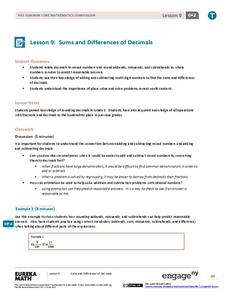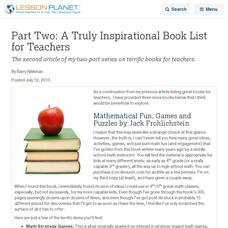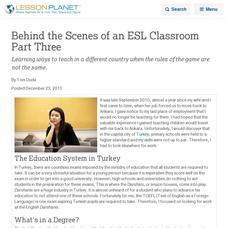American Chemical Society
Dissolving a Substance in Different Liquids
Second of six lessons in a unit on dissolving, this one focuses on how sugar behaves in different liquids. Learners stir it into water, alcohol, and oil and make observations. This lesson can stand alone, but is best used as part of the...
Baylor College
Observing Different Microbes
Following directions from a colorful slide preparation card, beginning biologists examine three different live microorganisms: bacteria, yeast, and paramecia. This is not an unusual activity to do with your class, but if you are doing it...
PBS
Venn Diagram: My Partner and I Are Different
Celebrate your class's diversity with this Venn diagram template. A perfect resource for building a classroom community at the beginning of the school year, pupils are able to learn about their peers while discovering what makes them...
2nd Grade Worksheets
Parts of a Friendly Letter
There are a lot of rules about formatting a friendly letter, but where do the commas go! Reinforce the grammar structure when writing a letter with a worksheet that prompts kids to choose the correct form of different parts of a letter,...
Curated OER
Plant Parts
Little ones identify the parts of a plant and practice following directions at the same time. They color each part of the flowering plant the color indicated on the sheet. Roots are brown, leaves are green, the flower is red, and the...
Curated OER
Plants Scavenger Hunt Activity
The hunt is on! Provide young botanists with a list of eighteen plant-related questions and let them loose as they search for answers on corresponding fact cards. Perform this activity in the classroom or use it as an opportunity to take...
Curated OER
How We Are Alike And Different
Students engage in a lesson that is concerned with the similarities and differences as part of knowing other children. They use examples of different drinks to illustrate the differences or similarities that are present in the student...
BW Walch
Daily Warm-Ups: Grammar and Usage
If grammar practice is anywhere in your curriculum, you must check out an extensive collection of warm-up activities for language arts! Each page focuses on a different concept, from parts of speech to verbals, and provides review...
Council for Economic Education
Banks and Credit Unions (Part 1)
Imagine you have money you want to save ... where do you put it? Pupils investigate the similarities and differences of banks and credit unions as they determine where exactly to place their hard-earned money. Through a WebQuest, they...
Curated OER
Crucigrama de las Partes del Cuerpo
What is the Spanish word for neck? What about foot? Give your beginning Spanish speakers this crossword puzzle to learn the Spanish translation for different body parts. Each body part is represented by a cartoon picture, and the learner...
Curated OER
Parts of a Microscope
In this biology lesson, students label and identify the different parts of a microscope. They complete 16 short answer questions about each part's function and complete 12 review questions in the end.
Curated OER
Life Cycle of Trees
Turn your students into young tree-tectives with this fun science investigation into the life of trees. To begin, a class volunteer gets dressed up in a tree costume as the different parts of trees are introduced. Then, the class learns...
Illustrative Mathematics
Money in the Piggy Bank
It's time to crack open that piggy bank and see what's inside. First, count up the pennies, nickels, dimes, and quarters, identifying what fraction of them are dimes. Then calculate the total value of the coins, writing another fraction...
Florida Center for Reading Research
Vocabulary: Word Meaning, Dictionary Digs
Young scholars dig through dictionaries to uncover the wealth of information they provide. Using the included graphic organizer, children learn about target words by finding their parts of speech, pronunciation, definition, synonyms, and...
Common Core Sheets
Comparing Numerically (Different Denominator)
Compare fractions with different denominators in a handy Common Core based worksheet. Fourth graders decide which fraction is larger or smaller based on the parts that make up a whole (denominator) and the parts being described...
Rational Number Project
Initial Fraction Ideas: Lesson 3
Visual models support young mathematicians as they deepen their fractional number sense in this elementary math lesson. Using fraction circle manipulatives, children explore basic unit fractions as they develop the fundamental...
EngageNY
Sums and Differences of Decimals
Sometimes dealing with decimals is so much easier than dealing with fractions. The ninth lesson in a 21-part module has the class consider situations when it might be easier to add or subtract fractions by first converting to decimals....
Curated OER
Part Two: A Truly Inspirational Book List for Teachers
The second article of my two-part series on terrific books for teachers.
Curated OER
Behind the Scenes of an ESL Classroom Part Three
Learning ways to teach in a different country when the rules of the game are not the same.
Curated OER
Lesson: An Exploration of Places and Spaces Part I
The concept behind this lesson is fantastic. Learners explore how different locations and situations affect them as individuals, focusing heavily on the impact of the urban environment. They question how location can make them change...
Council for Economic Education
Satisfaction Please! (Part 2)
Simply understanding consumer rights may not help people solve their problems. Understanding who to turn to becomes key in many different scenarios. Teach the value of various organizations that fight for consumer rights through...
Curated OER
The Parts of a Newspaper
Tenth graders examine the parts of a newspaper. They observe a PowerPoint presentation. Students participate in a research project to recognize the different types of materials each newspaper section contains. They read, summarize, and...
Curated OER
Parts of Speech Staircase
Students are introduced to the various parts of speech. Using construction paper, they make their own parts of speech staircase and use markers to write the different parts of speech on different flaps. To end the lesson, they write the...
Curated OER
Etymology
Learners dissect and build words from parts like prefixes, base words, suffixes, and inflectional endings. Etymology skills help us find the meanings of words by identifying the different parts that constitute them. Class members use...
Other popular searches
- Label Different Animal Parts
- Different Parts of Volcano
- Different Parts of Speech
- Different Parts Ofspeech

























